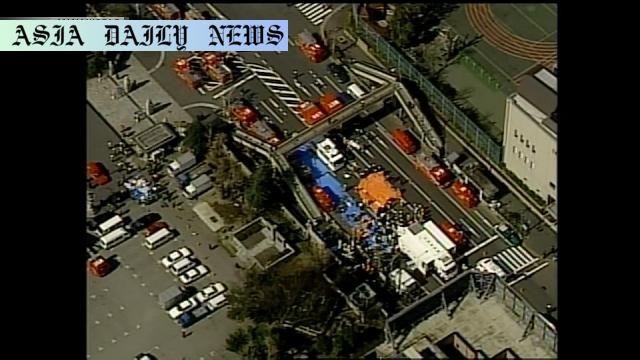1995 Tokyo sarin gas attack: Over 80% feel public memory is fading about the tragic subway gas attack impacting thousands.
- Over 80% of respondents feel the public memory of the 1995 Tokyo sarin gas attack is fading.
- The attack resulted in 14 deaths and injured thousands, leaving major health concerns among survivors.
- Many survivors still face lingering health conditions, some unsure if they are linked to sarin exposure.
- The survey highlights the need for ongoing public awareness and care for victims.

Remembering the Tragedy of 1995 Tokyo Sarin Gas Attack
The Tokyo subway sarin gas attack remains one of the most harrowing events in Japan’s recent history. On March 20, 1995, members of the Aum Shinrikyo cult unleashed a deadly nerve agent in Tokyo’s crowded subway system during rush hour. The chemical weapon, sarin, was covertly released inside packed carriages on three subway lines, resulting in the loss of 14 lives and causing injuries to approximately 6,300 others. This tragic attack not only terrorized a city but also left an indelible scar on Japan’s national psyche, raising questions about security, cult extremism, and societal awareness of such catastrophic incidents. But nearly three decades later, questions are emerging about the public memory of this infamous event.
A Survey Unveils Fading Public Memory
NHK conducted a survey in December ahead of the 30th anniversary of the attack to gauge public awareness and understand how those directly affected feel about its legacy. The survey included 133 participants who were victims or directly impacted by the sarin gas tragedy. Highlightingly, an overwhelming 87.2% of respondents expressed concerns that the memory of the attack is fading from public awareness. The data suggests a potential generational gap in understanding and cognizance of the attack, with survivors remarking that many younger individuals appear to be unaware of the incident altogether.
The Lingering Impact on Survivors
For many victims, the attack’s effects have not ended. Issues related to health, both physical and psychological, continue to plague the survivors even three decades later. Interestingly, more than half of the victims said they still grapple with health conditions, although they remain uncertain whether they are direct aftereffects of sarin exposure. Persistent symptoms, alongside emotional and mental scars, have cemented the event as a lasting trauma for those most affected. Moreover, over 80% of survey respondents believe they will need long-term care moving forward. This alarming statistic indicates that care, support services, and medical treatment for survivors remain critical priorities.
The Challenge of Preserving Historical Awareness
The notion that some might forget the Tokyo sarin gas attack is troubling, as it underscores the challenge of retaining public awareness about historical tragedies. The 1995 disaster became a national symbol of vulnerability to terrorism by domestic groups and heightened global understanding of the dangers of biochemical attacks. Survivors and commentators alike argue that public education and institutional measures can play a key role in ensuring that such events are remembered. Retelling survivors’ stories, observing anniversaries, and educating newer generations may preserve these events in public memory, fostering understanding about dangers that societies can face and how to mitigate them in the future.
Conclusion: Keeping Memory Alive
The 1995 Tokyo sarin gas attack remains an unprecedented catastrophe in modern history. For survivors, the wounds are still fresh, and the tragedy hasn’t been relegated to the past. Yet, with over 80% feeling that general awareness is dwindling, there is an urgent need to reignite discourse and remembrance around the incident. By doing so, not only will we wholeheartedly honor the victims and survivors, but also ensure that lessons learned from this tragedy are passed down to future generations.



Commentary
The Importance of Remembering the Past
Memory plays a crucial role in shaping a society’s identity and guiding its future. The 1995 Tokyo sarin gas attack was a monumental tragedy that highlighted the vulnerabilities of even the most advanced and peaceful societies. To see its memory fading, as suggested by the survey, is deeply concerning. Disasters like the Tokyo subway attack are not just historical events but teachable moments, and allowing their memory to slip undermines the lessons they offer about prevention, resilience, and the human cost of violence.
Survivors as Voices for Awareness
Survivors of the attack bear both the emotional and physical scars of the event. Their voices and experiences are invaluable tools for keeping the memory of the attack alive. Their stories provide insight into the ongoing challenges posed by trauma and health complications, even decades after the fact. Engaging survivors in public dialogues, documentaries, and events can offer a poignant reminder of the impact of such tragedies and reinforce public awareness over time.
A Call for Education and Commemoration
It is imperative for educational institutions, cultural organizations, and policymakers to prioritize preserving the memory of significant tragedies like the sarin gas attack. Schools can include content about it in history or sociology curricula, while public remembrance events can bridge generational gaps. Properly commemorating the attack not only honors the victims and survivors but also emphasizes the importance of preparedness and awareness regarding threats such as chemical terrorism.
Closing Thoughts
Letting events like the Tokyo sarin gas attack fade from public consciousness would mean disregarding the sacrifices and pain endured by its victims. More than that, it would be a lost opportunity to educate and prepare society for potential future challenges. By remembering this tragic event, we can continue to learn, grow, and better protect not just Japanese society, but humanity at large.